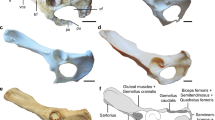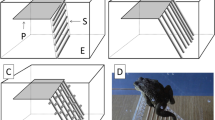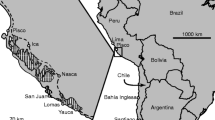Abstract
This paper provides a detailed description and the functional anatomy of the forelimb of an early Oligocene genet-sized arctoid carnivoran, Amphicynodon leptorhynchus, to infer its probable lifestyle. This work represents the first insights into the functional anatomy of the postcranial skeleton and palaeoecology of an emblematic member of the first radiation of arctoid carnivorans, the poorly known Amphicynodontidae, a group very likely related to bears. So far, the Amphicynodontidae have only been studied on the basis of their cranial and dental remains. The fossil site of Itardies (MP23, lower Oligocene), in the Quercy Phosphorites (France), have yielded hundreds of postcranial remains attributed to Am. leptorhynchus, allowing a complete analysis of its locomotor behaviour in comparison to a large sample of extant carnivorans showing diverse lifestyles. The anatomy of the forelimb of Am. leptorhynchus indicates well-developed climbing skills and grasping abilities. Thus, this early arctoid was probably living mostly in trees, moving on the ground basically for foraging as observed in small modern climbing carnivorans such as the red panda or the kinkajou, although some other climbing carnivorans can also live in rocky areas.




taken from Tarquini et al. (2019)


taken from Tarquini et al. (2019)



taken from Tarquini et al. (2019)





Similar content being viewed by others
Data Availability
All data generated or analysed during this study are included in this published article and its Supplementary Information files.
Code Availability
Graphs were created in R Version 3.6.2 with the ggplot2 package.
References
Aguilar JP, Legendre S, Michaux J (1997) Actes du congres BiochroM’97. Mémoires et travaux de l’Institut de Montpellier de l’école pratique des hautes études, Montpellier
Antón M, Salesa MJ, Pastor JF, Peigné S, Morales J (2006) Implications of the functional anatomy of the hand and forearm of Ailurus fulgens (Carnivora, Ailuridae) for the evolution of the “false-thumb” in pandas. J Anat 209:757–764
Argot C (2001) Functional-adaptive anatomy of the forelimb in the Didelphidae, and the paleobiology of the Paleocene marsupials Mayulestes ferox and Pucadelphys andinus. J Morphol 247:51–79
Argot C (2003) Functional adaptations of the postcranial skeleton of two Miocene borhyaenoids (Mammalia, Metatheria), Borhyaena and Prothylacinus, from South America. Palaeontology 46:1213–1267
Argot C (2004) Evolution of South American mammalian predators (Borhyaenoidea): anatomical and palaeobiological implications. Zool J Linn Soc 140:487–521
Astruc JG, Escarguel G, Maranda B, Simon-Coinçon R, Sigé B (2000) Floor-age constraining of a tectonic paroxysm of the Pyrenean orogen. Late middle Eocene mammal age of a faulted karstic filling of the Quercy phosphorites, south-western France. Geodinamica Acta 13:271–280
Barone R (2010) Anatomie Comparée des Mammifères Domestiques, Tome 1, Ostéologie. Éditions Vigot, Paris
Bonis L de (1974) Premières données sur les carnivores fissipèdes provenant des fouilles récentes dans le Quercy. Palaeovertebrata 6:27–32
Bonis L de, Gardin A, Blonde C (2019) Carnivora from the early Oligocene of the ‘Phosphorites du Quercy’ in southwestern France. Geodiversitas 41:601–621
Carbone C, Mace GM, Roberts SC, Macdonald DW (1999) Energetic constraints on the diet of terrestrial carnivores. Nature 402:286-288
Carbone C, Teacher A, Rowcliffe JM (2007) The costs of carnivory. PLoS Biology 5:e22
Cirot E (1992) Etude phylogénétique de quelques genres d’Arctoidea de l’Oligocène eurasiatique: comparaison des données morphologiques et moléculaires. Doctoral dissertation, Poitiers
Cirot E, Bonis L de (1992) Révision du genre Amphicynodon, carnivore de l’Oligocène. Palaeontogr Abt A 220:103–130
Davis DD (1949) The shoulder architecture of bears and other carnivores. Fieldiana Zool 31:285-305
Davis DD (1964) The Giant Panda: A Morphological Study of Evolutionary Mechanisms. Chicago Natural History Museum, Chicago
Durand-Delga M (2006) Sur la découverte des phosphorites du Quercy au renouveau de leur étude avec Bernard Gèze. Strata 13:25–36
Ercoli MD, Prevosti FJ, Álvarez A (2012) Form and function within a phylogenetic framework: locomotory habits of extant predators and some Miocene Sparassodonta (Metatheria): locomotion in sparassodonts and extant predators. Zool J Linn Soc 165:224–251
Ercoli MD, Youlatos D (2016) Integrating locomotion, postures and morphology: the case of the tayra, Eira barbara (Carnivora, Mustelidae). Mammal Biol 81:464–476
Evans HE, Lahunta A de (2013) Miller’s Anatomy of the Dog. Elsevier Saunders, St. Louis
Fabre AC, Cornette R, Slater G, Argot C, Peigné S, Goswami A, Pouydebat E (2013) Getting a grip on the evolution of grasping in musteloid carnivorans: a three-dimensional analysis of forelimb shape. J Evol Biol 26:1521–1535
Fabre AC, Goswami A, Peigné S, Cornette R (2014) Morphological integration in the forelimb of musteloid carnivorans. J Anat 225:19–30
Fabre AC, Cornette R, Goswami A, Peigné S (2015) Do constraints associated with the locomotor habitat drive the evolution of forelimb shape? A case study in musteloid carnivorans. J Anat 226:596–610
Fabre AC, Marigó J, Granatosky MC, Schmitt D (2017) Functional associations between support use and forelimb shape in strepsirrhines and their relevance to inferring locomotor behavior in early primates. J Hum Evol 108:11–30
Finarelli JA (2008) A total evidence phylogeny of the Arctoidea (Carnivora: Mammalia): relationships among basal taxa. J Mammal Evol 15:231-259
Fisher RE, Adrian B, Barton M, Holmgren J, Tang SY (2009) The phylogeny of the red panda (Ailurus fulgens): evidence from the forelimb. J Anat 215:611–635
Fujiwara S (2009) Olecranon orientation as an indicator of elbow joint angle in the stance phase, and estimation of forelimb posture in extinct quadruped animals. J Morphol 270:1107–1121
Gebo DL, Rose KD (1993) Skeletal morphology and locomotor adaptation in Prolimnocyon atavus, an early Eocene hyaenodontid creodont. J Vertebr Paleontol 13:125–144
Gittleman JL (1985) Carnivore body size: ecological and taxonomic correlates. Oecologia 67:540–554
Heinrich R, Houde P (2006) Postcranial anatomy of Viverravus (Mammalia, Carnivora) and implications for substrate use in basal Carnivora. J Vertebr Paleontol 26:422–435
Henderson K, Pantinople J, McCabe K, Richards HL, Milne N (2017) Forelimb bone curvature in terrestrial and arboreal mammals. PeerJ 5:e3229
Hunt RM (2002) New amphicyonid carnivorans (Mammalia, Daphoeninae) from the early Miocene of southeastern Wyoming. Am Mus Novit 2002:1–41
Iwaniuk AN, Pellis SM, Whishaw IQ (1999) The relationship between forelimb morphology and behaviour in North American carnivores (Carnivora). Can J Zool 77:1064–1074
Janis CM, Scott KM, Jacobs LL (1998) Evolution of Tertiary Mammals of North America: Volume 1, Terrestrial Carnivores, Ungulates, and Ungulate Like Mammals. Cambridge University Press, Cambridge, pp 73–246
Legendre S (1987) Les communautés mammifères d’Europe occidentale de l’Eocène supérieur et Oligocène : structures et milieux. Münch Geowis Abh A10:301–312
McClearn D (1992) Locomotion, posture, and feeding behavior of kinkajous, coatis, and raccoons. J Mammal 73:245-261
McEvoy JS (1982) Comparative myology of the pectoral and pelvic appendages of the North American porcupine (Erethizon dorsatum) and the prehensile-tailed porcupine (Coendou prehensilis). Bull Am Mus Natl Hist 173:337–421
Meng J, McKenna MC (1998) Faunal turnovers of Palaeogene mammals from the Mongolian Plateau. Nature 394:364-367
Morgan CC (2009) Geometric morphometrics of the scapula of South American caviomorph rodents (Rodentia: Hystricognathi): form, function and phylogeny. Mammal Biol, 74: 497-506
Oxnard CE (1968) The architecture of the shoulder in some mammals. J Morphol 126:249–290
Peigné S, Bonis L de (2003) Juvenile cranial anatomy of Nimravidae (Mammalia, Carnivora): biological and phylogenetic implications. Zool J Linn Soc 138:477–493
Salesa MJ, Antón M, Peigné S, Morales J (2006) Evidence of a false thumb in a fossil carnivore clarifies the evolution of pandas. Proc Natl Acad Sci USA 103:379–382
Salesa MJ, Antón M, Peigné S, Morales J (2008) Functional anatomy and biomechanics of the postcranial skeleton of Simocyon batalleri (Viret, 1929) (Carnivora, Ailuridae) from the late Miocene of Spain. Zool J Linn Soc 152:593–621
Samuels JX, Van Valkenburgh B (2008) Skeletal indicators of locomotor adaptations in living and extinct rodents. J. Morphol 269: 1387-1411
Samuels JX, Meachen JA, Sakai SA (2013) Postcranial morphology and the locomotor habits of living and extinct carnivorans. J Morphol 274: 121-146
Sargis EJ (2002) Functional morphology of the forelimb of tupaiids (Mammalia, Scandentia) and its phylogenetic implications. J Morphol 253:10–42
Schaller O, Constantinescu GM (2007) Illustrated Veterinary Anatomical Nomenclature. Enke Verlag, Stuttgart
Sigé B, Aguilar JP, Astruc JG, Mandarat B (1991) Extension au Miocène inférieur des remplissages phosphatés du Quercy. La faune de vertébrés de Crémat (Lot, France). Geobios, Lyon 24:497–502
Siliceo G, Salesa MJ, Antón M, Pastor JF, Morales J (2015) Comparative anatomy of the shoulder region in the late Miocene amphicyonid Magericyon anceps (Carnivora): functional and paleoecological inferences. J Mammal Evol 22:243–258
Stalheim-Smith A (1984) Comparative study of the forelimbs of the semifossorial prairie dog, Cynomys gunnisoni, and the scansorial fox squirrel, Sciurus niger. J Morphol 180:55–68
Tarquini J, Morgan CC, Toledo N, Soibelzon LH (2019) Comparative osteology and functional morphology of the forelimb of Cyonasua (Mammalia, Procyonidae), the first South American carnivoran. J Morphol 280:446–470
Tarquini J, Toledo N, Morgan CC, Soibelzon LH (2017). The forelimb of †Cyonasua sp. (Procyonidae, Carnivora): ecomorphological interpretation in the context of carnivorans. Earth Environ Sci Trans R Soc Edinburgh, 106:325-335
Tarquini J, Toledo N, Soibelzon LH, Morgan CC (2018) Body mass estimation for †Cyonasua (Procyonidae, Carnivora) and related taxa based on postcranial skeleton. Hist Biol 30:496–506
Taverne M, Fabre AC, Herbin M et al (2018) Convergence in the functional properties of forelimb muscles in carnivorans: adaptations to an arboreal lifestyle? Biol J Linn Soc 125:250–263
Taylor ME (1970) Locomotion in some East African viverrids. J Mammal 51:42-51
Taylor ME (1974) The functional anatomy of the forelimb of some African Viverridae (Carnivora). J Morphol 143:307–335
Taylor ME (1989) Locomotor adaptations by carnivores. In: Gittleman Jl (ed) Carnivore Behavior, Ecology and Evolution. Volume 1. Comstock Publishing Associates, Ithaca, pp 382–409
Toledo N, Bargo MS, Cassini GH, Vizcaíno SF (2012) The forelimb of early Miocene sloths (Mammalia, Xenarthra, Folivora): morphometrics and functional implications for substrate preferences. J Mammal Evol, 19:185-198
Tomiya S, Tseng ZJ (2016) Whence the beardogs? Reappraisal of the middle to late Eocene ‘Miacis’ from Texas, USA, and the origin of Amphicyonidae (Mammalia, Carnivora). R Soc Open Sci 3:160518
Trapp GR (1972) Some anatomical and behavioral adaptations of ringtails, Bassariscus astutus. J Mammal 53:549–557
Van Valkenburgh B (1987) Skeletal indicators of locomotor behavior in living and extinct carnivores. J Vertebr Paleontol 7:162–182
Van Valkenburgh B (1990) Skeletal and dental predictors of body mass in carnivores. In: Damuth J, MacFadden BJ (ed) Body Size in Mammalian Paleobiology. Estimation and Biological Implications. New York: Cambridge University Press, Cambridge, pp 181-205
Vianey-Liaud M, Legendre S (1986) Les faunes des phosphorites du Quercy: principes méthodologiques en paléontologie des mammifères; homogénéité chronologique des gisements de mammifères fossiles. Eclogae Geologicae Helvetiae 79:917–944
Vianey-Liaud M, Schmid B (2009) Diversité, datation et paléoenvironnement de la faune de mammifères oligocènes de Cavalé (Quercy, SO France) : contribution de l’analyse morphométrique des Theridomyinae Mammalia, Rodentia). Geodiversitas 31:909–941
Wang B, Qiu Z (2003) Notes on early Oligocene ursids (Carnivora, Mammalia) from Saint Jacques, Nei Mongol, China. Bull Am Mus Natl Hist 279:116–124
Wang X, McKenna MC, Dashzeveg D (2005) Amphicticeps and Amphicynodon (Arctoidea, Carnivora) from Hsanda Gol Formation, central Mongolia and phylogeny of basal arctoids with comments on zoogeography. Am Mus Novit, 1–60
Wang X, Rothschild BM (1992) Multiple hereditary osteochondroma in oligocene Hesperocyon (Carnivora: Canidae). J Vertebr Paleontol 12:387–394
Wickham H (2016) ggplot2: elegant graphics for data analysis. Springer Nature
Wilson DE, Mittermeier RA (2009) Handbook of the Mammals of the World, vol. 1. Carnivores. Lynx Editions, Barcelona
Acknowledgements
This research was funded by the French CNRS in the frame of the “Recherche coopérative sur programme : Phosphorites du Quercy”. This work is part of the master's thesis of AG, who received financial assistance for international mobility: ERASMUS+ grant from the Faculté des Sciences of the Université de Montpellier (France) and AMI grant from the French Ministry of Higher Education and Research and Innovation. The article is greatly indebted to all the people who worked with LdB in the locality Itardies. We thank the members of PALEVOPRIM (University of Poitiers) and the Museo Nacional de Ciencias Naturales-CSIC, where this paper was prepared, and especially Camille Grohé for our constructive discussions. Furthermore, we wish to acknowledge Nahuel Muñoz and an anonymous reviewer for their comments which greatly improved the paper. We thank the Anatomical Collections of the Museo Nacional de Ciencias Naturales-CSIC (especially its curator, Ángel Luis Garvía), and the Museo Anatómico de la Universidad de Valladolid for providing the large sample of skeletons of extant carnivorans used for comparison.
Funding
The research was funded by the French CNRS in the frame of the “Recherche coopérative sur programme: Phosphorites du Quercy”. This work is part of the master's thesis of AG, who received financial assistance for international mobility: ERASMUS + grant from the Faculté des Sciences of the Université de Montpellier (France) and AMI grant from the French Ministry of Higher Education and Research and Innovation.
Author information
Authors and Affiliations
Contributions
Louis de Bonis and Manuel J. Salesa designed the study. Louis de Bonis and Axelle Gardin made the descriptions of the forelimb of Am. leptorhynchus. Axelle Gardin analysed and interpreted the forelimb anatomy and draft the manuscript. All the authors revised and improved the writing of this manuscript.
Corresponding author
Ethics declarations
Conflict of Interest
The authors declare no conflict of interest.
Supplementary Information
Below is the link to the electronic supplementary material.
Rights and permissions
About this article
Cite this article
Gardin, A., Salesa, M.J., Siliceo, G. et al. Climbing Adaptations of an Enigmatic Early Arctoid Carnivoran: the Functional Anatomy of the Forelimb of Amphicynodon leptorhynchus From the Lower Oligocene of the Quercy Phosphorites (France). J Mammal Evol 28, 785–811 (2021). https://doi.org/10.1007/s10914-021-09553-w
Accepted:
Published:
Issue Date:
DOI: https://doi.org/10.1007/s10914-021-09553-w




